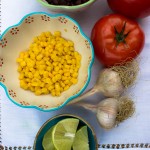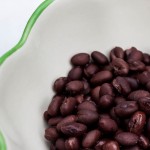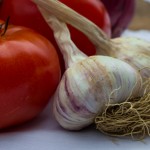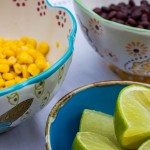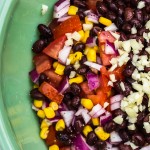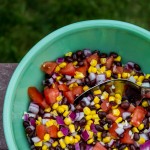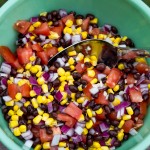This Meatless Monday, we feature corn, with growing, storage and prep tips, as well as recipes for Corn and Bean Salsa and Roasted Corn on the Cob from Vermont Fresh: A Fruit and Vegetable Handbook.
Background
Corn is one of North America’s oldest and most symbolic foods. Together with winter squash and beans, corn was one of the “three sister” foods that were staples of the Native American diet for centuries. Fossilized grains of corn date the crop to many thousands of years ago. Corn was one of the first crops to be cultivated and traded by Native Americans; there were widespread fields of it by the time European explorers appeared. Also called “maize,” corn was integral to the diet of early American colonists, who learned how to grow it from Native Americans. Corn, which is actually a grain, can be ground into flour like wheat, but some varieties are eaten in their immature state as “sweet corn,” which is commonly considered a vegetable. Second to rice, corn is the world’s most widespread crop, with the United States leading production. It is perhaps the world’s most heavily genetically modified crop. Today, corn is grown for livestock feed, corn-syrup production, ethanol fuel, and plain old eating (which is probably the most well known-type of corn).
Growing Tips
Sweet corn is most often seeded directly into the garden once the soil has warmed and frost is no longer a threat, but it can also be transplanted to get a jump on the growing season and avoid kernel-eating pests (start seeds 4 weeks before setting outside). Corn is a warmth-loving vegetable that needs full sunlight. Seeds should be planted about 1 inch deep with about 6 inches between plants. Don’t forget to leave walking space between rows! Corn needs to be well fertilized with compost. Corn is ready to harvest when the ears are fat, have dried-down silk tassels, and their kernels squirt liquid when pierced. You can peel the husk back on an ear to check for readiness, but leave the remaining ears fully intact to avoid damage from pests. Corn is susceptible to attack from raccoons.
Storage
Corn is best eaten as soon as possible after it is picked. It can be refrigerated for a short period of time. Once an ear of corn is removed from the stalk, the kernels’ sugars begin turning to starch, making the corn mealy. If your corn cannot be consumed fresh, freeze loose kernels or on the cob after blanching.
Nutritional Benefits
Sweet corn has a high fiber, protein, and potassium content. Sweet corn is very easy for humans to digest. The fresher the corn, the less starch it will contain and the more vitamins and minerals.
Preparation
When buying corn, choose full ears with bright green husks, avoiding ears with shriveled or overly large kernels. Classic corn on the cob is shucked, boiled in salted water, and served with butter. With the husks left on, ears of corn can be soaked in water and roasted in the oven (or in a fire if wrapped in foil). Also great eaten raw right off the cob.
Meatless Monday Recipe: Roasted Corn on the Cob
Serves 3
Ingredients
- 6 ears of corn (or as many as desired)
- Butter
Instructions
- Soak ears of corn, husks on, in a sink or bucket full of water for 1-2 hours.
- Pre-heat oven to 450°F (note: you can also put them on a grill). Roast soaked ears (husks still intact) for 15 minutes directly on the rack. Turn once with tongs for even cooking.
- Remove from oven and, when ears are cool enough to handle, remove husks and silk.
- Serve hot with butter. Salt, pepper, grated cheese, and chili powder are also tasty toppings!
Meatless Monday Recipe: Fresh Corn and Bean Salsa
Kate Pace, a volunteer baking, tasting and testing recipes out of the Vermont Fresh Handbook tried out this recipe. Her comments and adjustments are in italics within the recipe below. You can find her on Facebook.
- Photo courtesy of Kate Pace
- Photo courtesy of Kate Pace
- Photo courtesy of Kate Pace
- Photo courtesy of Kate Pace
- Photo courtesy of Kate Pace
- Photo courtesy of Kate Pace
- Photo courtesy of Kate Pace
Serves many or 12 servings with fish/chicken (etc)
20 minutes total
Ingredients
- 2 cans black beans, drained and rinsed
- 1 can corn, drained (or about 2 cups fresh corn kernels)
- 2 cans diced tomatoes (or 2 large fresh tomatoes, diced) **local tomatoes are in abundance, go for those, they have the best flavor. Yum!
- 1 onion, finely chopped
- 1 pepper, finely chopped (red, green or yellow; or 1 fresh jalapeno, de-ribbed & seeded, chopped fine for heat!)
- 2 tsp garlic
- 2 tbs lime juice (optional)
- Handful cilantro leaves, chopped (optional) If you don’t have cilantro, you can add a dash of ground coriander (or we like cumin)
- Salt and Pepper to taste
Instructions
- Mix together all ingredients.
- Chill and Serve.
To receive more recipes and tips on your favorite fruits and vegetables, download Vermont Fresh: A Fruit and Vegetable Handbook. Vermont Foodbank fresh food initiatives would not be possible without your support. Please consider giving to the Vermont Foodbank today!


